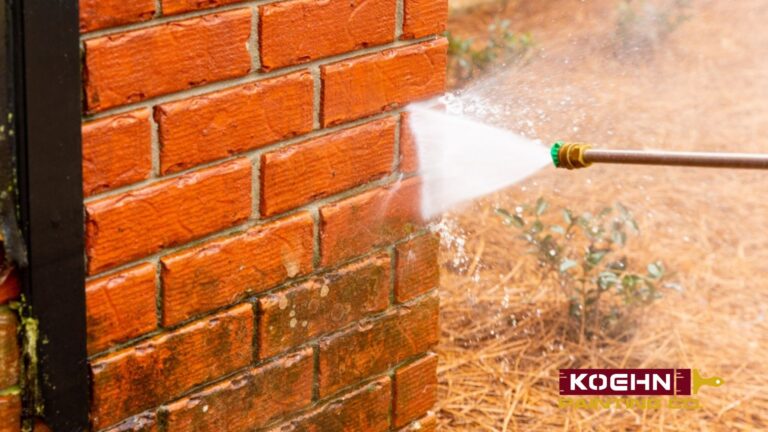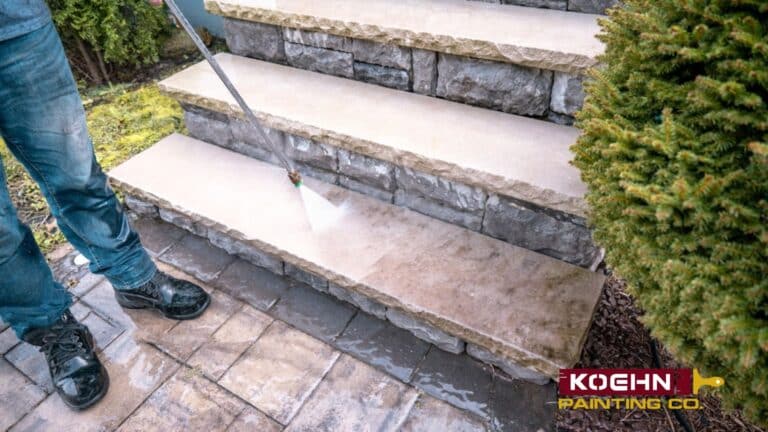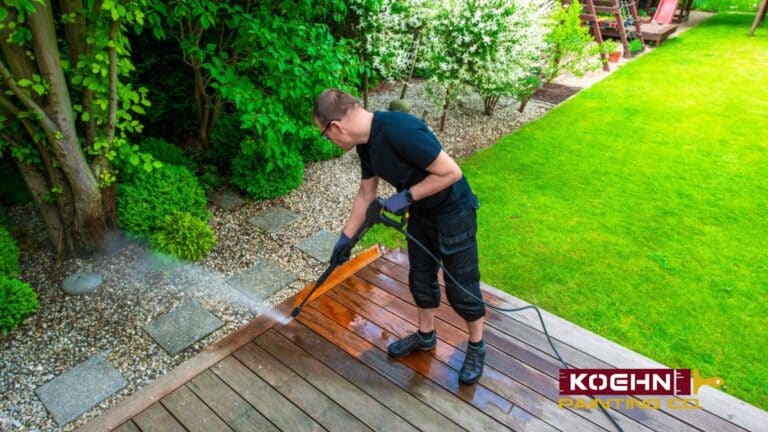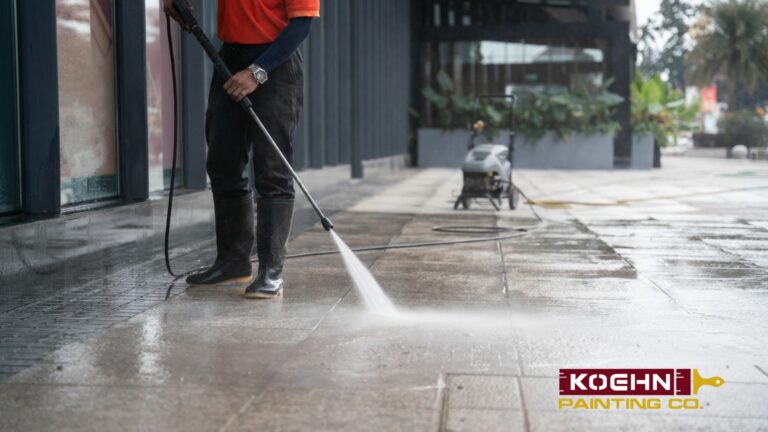What Is the PSI for Pressure Washing a House
Understanding the appropriate PSI for pressure washing a house is crucial for achieving optimal cleaning results without causing surface damage.
PSI (pounds per square inch) measures the force of the water spray, and when paired with GPM (gallons per minute), it forms the cleaning power of your pressure washer.
High PSI provides a stronger force suitable for tough surfaces like concrete, while lower PSI is safer for delicate materials such as vinyl or wood siding. Equally important is selecting the right nozzle angle and maintaining the proper distance to control effective PSI.
Professional-grade cleaning units are calculated by multiplying PSI and GPM, highlighting the importance of water flow as much as pressure.
Each surface type has its ideal PSI range to ensure thorough cleaning without the risk of damage:
- Vinyl siding requires 1,300–1,500 PSI, with a maximum of 2,000 for stubborn stains
- Wood siding should stay between 800–1,200 PSI to prevent gouging
- Stucco, being porous and fragile, is best cleaned with 1,200–1,500 PSI
- Brick surfaces should remain under 1,000 PSI to avoid eroding the mortar
- Concrete can handle more pressure, typically 2,000–2,800 PSI, but exceeding 3,000 PSI risks surface etching
- Delicate areas like windows and fiber cement siding should be cleaned using soft washing techniques with no PSI at all
Ultimately, understanding and using the correct PSI for each material is key to effective and safe house maintenance, ensuring surfaces are cleaned properly without turning routine care into costly repairs. Let’s explore this topic further.
Understanding Pressure Washer PSI: The Basics Explained
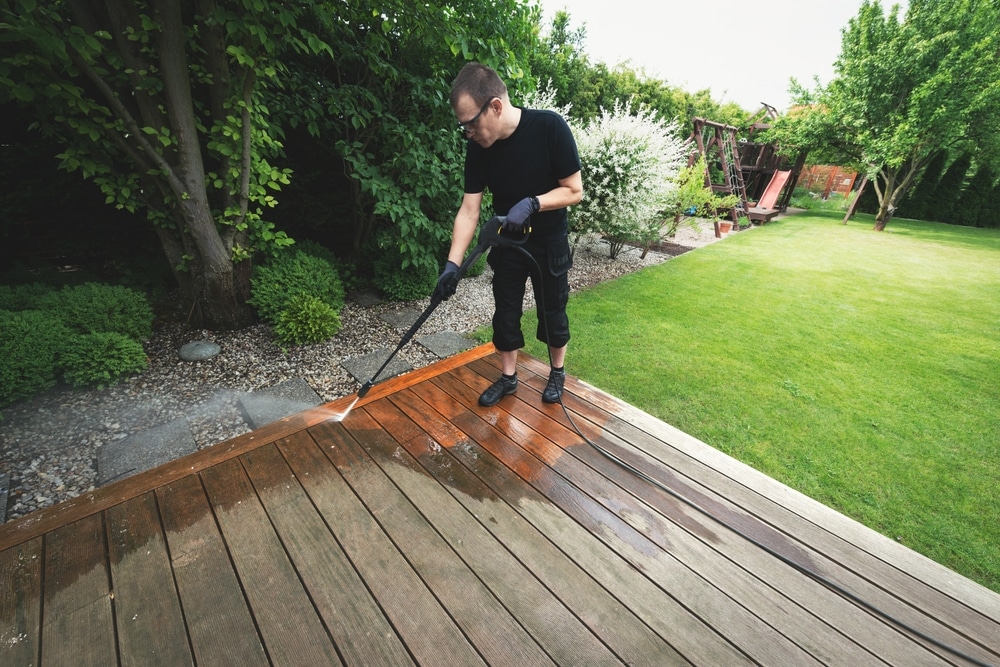
Before deciding how much pressure your home’s exterior can handle, it’s helpful to understand exactly what PSI means in a pressure washer context. PSI stands for pounds per square inch, measuring the force of the water spray from your machine. A higher PSI indicates a stronger blast capable of removing stubborn grime, mold, and even paint. Conversely, a lower PSI is gentler, making it safer for delicate surfaces like wood or vinyl siding.
When choosing the right PSI for pressure washing a house, you’re balancing cleaning effectiveness with surface safety. Too low pressure, and you’ll spend hours with poor results. Too high, and you could gouge wood, crack siding, or push water behind panels where it shouldn’t go. That’s why knowing the correct PSI is essential.
PSI and GPM: The Dynamic Duo
While PSI is the most commonly discussed specification, GPM (gallons per minute) is equally important. PSI determines how forcefully the water hits the surface; GPM determines how much water flows out. In other words, PSI loosens the dirt, while GPM rinses it away.
Here’s how they interact:
- High PSI, low GPM: A strong blast that can break up tough stains, but slow rinsing means it takes longer to finish the job.
- Low PSI, high GPM: Gentler force, but more water volume to sweep debris quickly; ideal for large surfaces that don’t need an aggressive blast.
- Balanced PSI and GPM: The sweet spot for most homeowners, combining enough power to loosen grime with enough flow to wash it clean.
Professionals often use a formula called Cleaning Units (CU), which multiplies PSI × GPM. For example:
- A 3,000 PSI washer at 2.0 GPM = 6,000 CU
- A 2,000 PSI washer at 3.0 GPM = 6,000 CU
Both seem equal on paper, but in real-world house washing, the 2,000 PSI / 3.0 GPM setup may actually clean faster because the higher water flow helps rinse debris more effectively.
Nozzles: The Hidden Variable
Even with the same pressure washer, your nozzle choice changes the effective PSI at the point of contact.
- Narrow-angle nozzle (0° or 15°): Concentrates water for maximum force—great for concrete but too harsh for siding.
- Wider-angle nozzle (25° or 40°): Spreads out the water, lowering impact and making it safer for painted or delicate surfaces
- Adjustable distance: Simply stepping back a few feet can reduce effective PSI, giving you more control without switching nozzles.
Practical Tips for Homeowners
When learning how to use PSI for pressure washing a house, keep these guidelines in mind:
- Start low, then adjust. Begin with a wider nozzle and lower PSI. If it’s not cleaning effectively, move up gradually.
- Test a hidden spot. Always try your settings on an inconspicuous area first to make sure you’re not damaging siding, trim, or paint.
- Match PSI to the surface. Use higher PSI for tough surfaces like brick or concrete. Stick to lower ranges for siding, wood, or painted finishes.
- Don’t forget GPM. A moderate PSI with strong water flow is often more efficient—and safer—than brute-force pressure alone.
- Use the right nozzle. It’s the difference between a clean surface and a costly repair bill.
Understanding pressure washer PSI is key. The right balance of PSI, GPM, and nozzle choice ensures that you clean effectively without damage.
If you don’t know this, you could turn a simple maintenance job into a repair project. But, when you do, you’ll have a clean, well-prepared surface ready for painting, refinishing, or just looking its best.
But let’s skip the general concepts and go straight to the specifics: what’s the best PSI for pressure washing your house?
Contact us here if you would like to find the best painting contractor for your residential or commercial painting needs.
What’s the Best PSI to Pressure Wash a House?

One of the most common questions homeowners ask is: What PSI pressure washer should I get for my house? It’s a fair question, because the answer directly impacts how safe and effective your cleaning will be.
The truth is, there isn’t one single number that works for every situation. The best PSI for a house depends on the type of surface you’re cleaning and how much buildup you’re trying to remove.
Understanding the right pressure washer PSI is essential because it balances power with preservation. Too little pressure, and you’ll spend hours fighting stains that never budge. Too much, and you risk cracking stucco, shredding paint, or damaging the very surfaces you’re trying to protect.
So, let’s break it down by surface type and scenario, so you can confidently decide the correct PSI for pressure washing a house without second-guessing.
1. Vinyl Siding (Safe Range: 1,300-1,500 PSI)
Vinyl siding is one of the most common exterior materials—and one of the trickiest when it comes to water pressure. While durable, vinyl can warp or crack under too much force.
- Recommended range: 1,300–1,200 PSI, with up to 2,000 PSI for stubborn spots.
- Risks of going too high: Water forced under panels can cause mold growth inside walls, and high PSI can leave visible streaks or cracks.
Imagine you set your washer to 3,000 PSI, thinking “more power equals faster cleaning.” Within seconds, you notice the siding flex and hear a crack. Now you’re not just cleaning, you’re replacing panels. By contrast, staying within 1,500 PSI gets the job done safely, especially when paired with detergent.
2. Wood Siding (Safe Range: 800-1,200 PSI)
Wood is beautiful but vulnerable. The wrong approach can strip paint, raise the grain, or even carve grooves into the surface.
- Recommended range: 800–1,200 PSI.
- Risks of going too high: Permanent gouges, splintering, or water penetration that causes rot.
Think of a homeowner who sets the washer at 2,500 PSI to “save time.” The result, sadly, is chipped paint and exposed wood fibers that now require sanding and repainting. Sticking to around 1,000 PSI avoids damage while still lifting dirt, mildew, and loose paint gently.
3. Stucco (Safe Range: 1,200-1,500 PSI)
Stucco has a textured, porous surface that can hold dirt, but it’s also fragile. Too much PSI can chip off layers or create holes.
- Recommended range: 1,200–1,500 PSI.
- Risks of going too high: Flaking, cracks, or pressure pushing water deep into porous sections.
Think about it. You angle a high-pressure nozzle directly at a stucco wall. Instead of a clean surface, chunks of stucco fly off, leaving expensive repair work. Keeping it under 1,500 PSI and using a wider nozzle avoids disaster.
4. Brick & Mortar (Safe Range: 500–1,000 PSI)
Brick can handle a lot, but the real weak spot is the mortar. Hit it with too much pressure and you’ll erode the joints, which weakens the wall over time.
- Recommended range: 500–1,000 PSI, with no more than 1,500 PSI for especially stubborn stains.
- Risks of going too high: Washed-out mortar, loose joints, water seeping behind the brick, and structural instability down the line.
Don’t be that DIYer who cranks the washer up to 3,000 PSI to blast away algae. The algae disappears, but so does the mortar between the bricks.
Instead of a clean wall, they’re left with crumbling joints that now need costly repairs. Sticking to about 1,000 PSI (and using detergent when needed) gets the job done safely.
5. Concrete (Safe Range: 2,000–2,800 PSI)
Concrete can handle more force, which is why driveways, patios, and sidewalks need higher PSI.
- Recommended range: 2,000–2,800 PSI.
- Risks of going too low: Dirt, oil, and tire marks won’t lift.
- Risks of going too high: Etching the surface, leaving visible streaks and roughness patches.
This is where you give it your all. Think about the gentle treatment you must use with materials like wood. When pressure washing a driveway at only 1,200 PSI, oil stains may still remain hours later.
Increase the pressure to 2,500 PSI, confidently, and with the right nozzle, those stains can be gone in minutes. Just be sure not to go beyond 3,000 PSI—that’s too much.
6. Delicate Areas (Windows, Trim, Fiber Cement Siding)
Not every surface should be hit with high PSI. For delicate areas, soft washing is the only safe method.
- Recommended approach: Soft wash with detergents, brushes, and a standard garden hose.
- Risks of using PSI: Cracked glass, water intrusion, or paint stripped off trim.
Think about blasting window trim with 2,000 PSI. Instead of sparkling windows, you’re left with cracked caulk and a soaked interior wall. A soft wash would have avoided the damage.
Why Getting PSI Right Is Non-Negotiable
When asking What is the best PSI for a house?, the answer is: it depends on the material. And the stakes are high:
- Too low: You waste time, water, and energy by scrubbing endlessly without seeing real results.
- Too high: You cause irreversible damage, turning maintenance into a repair bill.
The best approach is to treat PSI like seasoning food: start light, test carefully, and only increase when absolutely necessary.
Before you pressure wash a house, take a good look at this comparative table
| Surface Type | Safe PSI Range | Risks of Too Low | Risks of Too High | Best Practice |
| Vinyl Siding | 1,300–1,500 PSI (up to 2,000 for stubborn spots) | Grime lingers, mold and mildew stay embedded | Warping, cracks, water forced behind panels | Use detergent + 25° nozzle; keep distance at ~3 ft. |
| Wood Siding | 800–1,200 PSI | Dirt remains, mildew not fully removed | Gouges, splintering, raised grain, water penetration | Stay around 1,000 PSI; test hidden spots first. |
| Stucco | 1,200–1,500 PSI | Stains remain trapped in pores | Flaking, holes, deep water penetration | Use wide-angle nozzle; never direct stream head-on. |
| Brick & Mortar | 500–1,000 PSI (max 1,500 for stubborn stains) | Algae, moss, and dirt won’t lift properly | Mortar erosion, loose joints, structural weakening | Stick near 1,000 PSI + detergent when needed. |
| Concrete/Driveways | 2,000–2,800 PSI | Oil stains, tire marks remain | Etching, streaks, rough patches | Go 2,500 PSI for stains; avoid exceeding 3,000 PSI. |
| Delicate Areas (Windows, Trim, Fiber Cement) | Soft wash only (garden hose, soap, brush) | Dust and pollen not fully cleaned | Cracked glass, stripped paint, water intrusion | Skip PSI—use soft washing with cleaning solutions. |
The Bottom Line on PSI for Pressure Washing A House
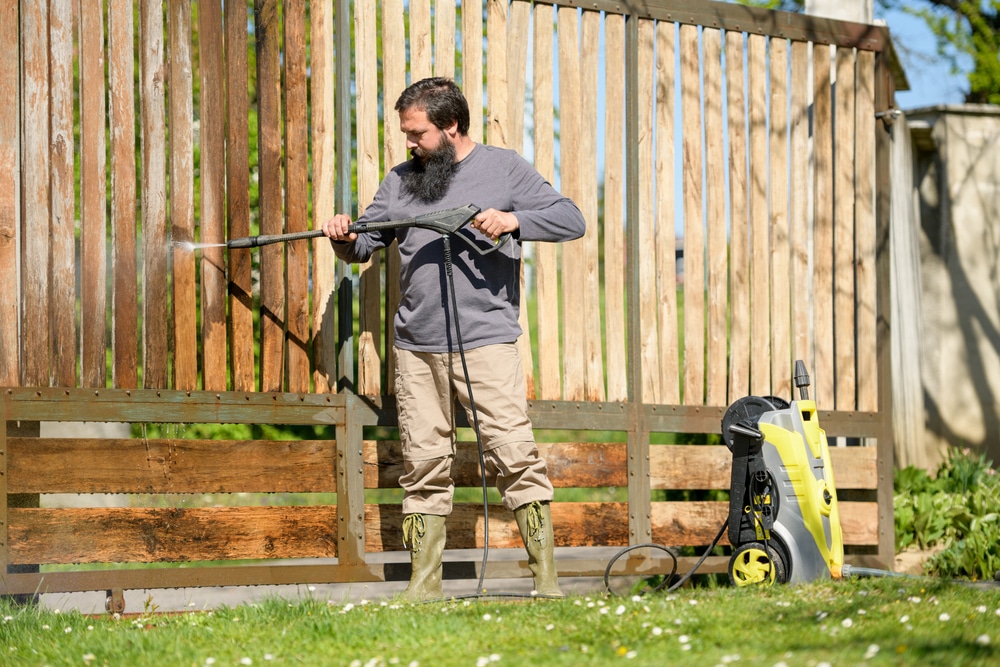
Ultimately, the right PSI for pressure washing a house isn’t about using the most powerful machine to save time. It’s about adjusting the pressure to suit the surface. Vinyl, wood, stucco, brick, and concrete each have different safe limits, and exceeding those can turn a simple cleaning into costly repairs.
So, what is the best PSI for a house? The answer depends. For most siding, you’ll want to stay between 1,200–1,500 PSI. For tougher surfaces like concrete driveways, you can safely push up toward 2,800 PSI. And for delicate areas like windows and trim, the safest choice is no PSI at all—stick with soft washing.
Knowing pressure washer PSI helps you clean confidently and safely. It also prepares you for bigger tasks like repainting, sealing, or refinishing. By choosing the right settings, you protect your property, extend the life of your surfaces, and achieve results that look professional.
Discover the Koehn Painting difference – contact us today for a free estimate and step into a vibrant, freshly painted home!


